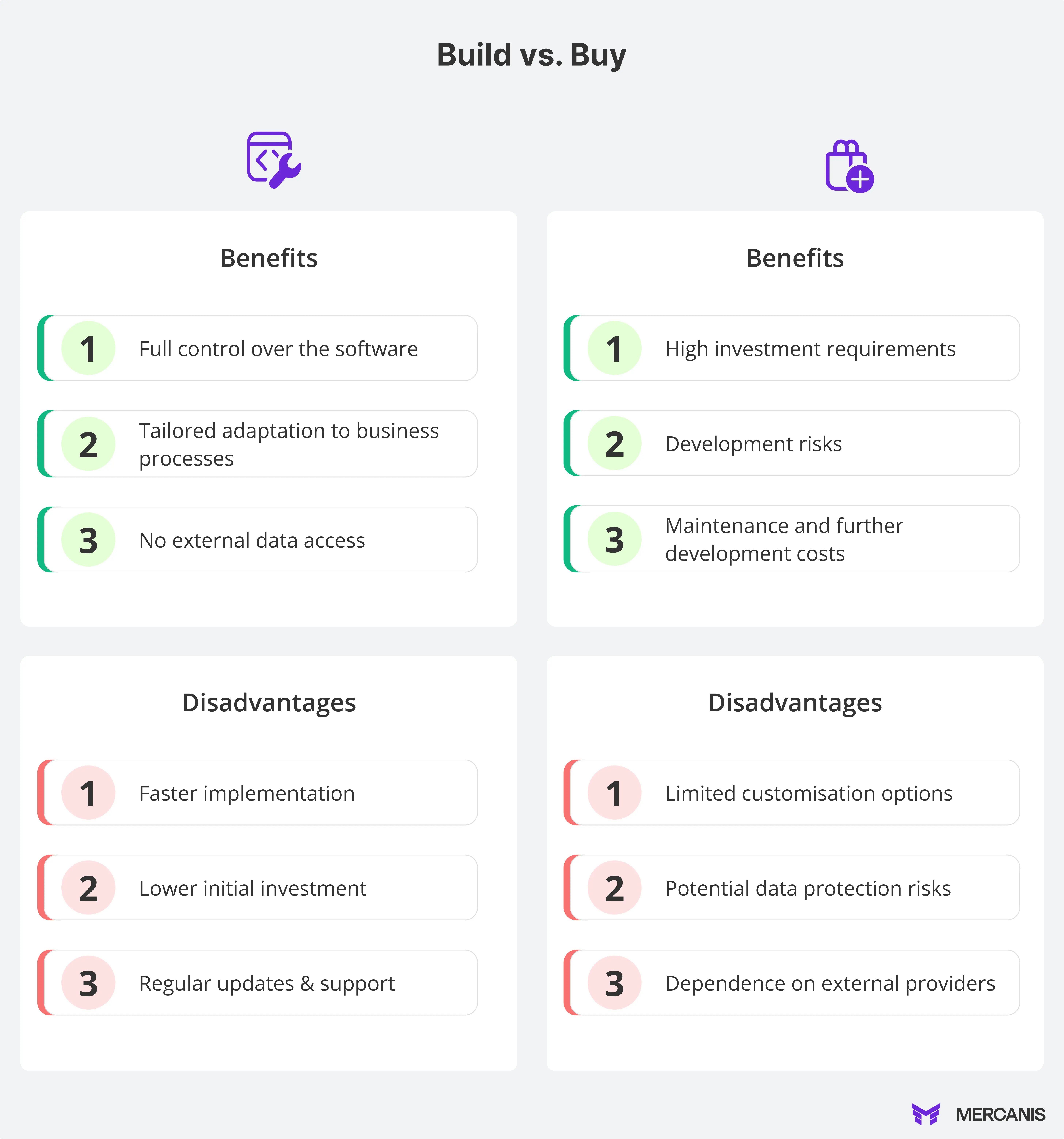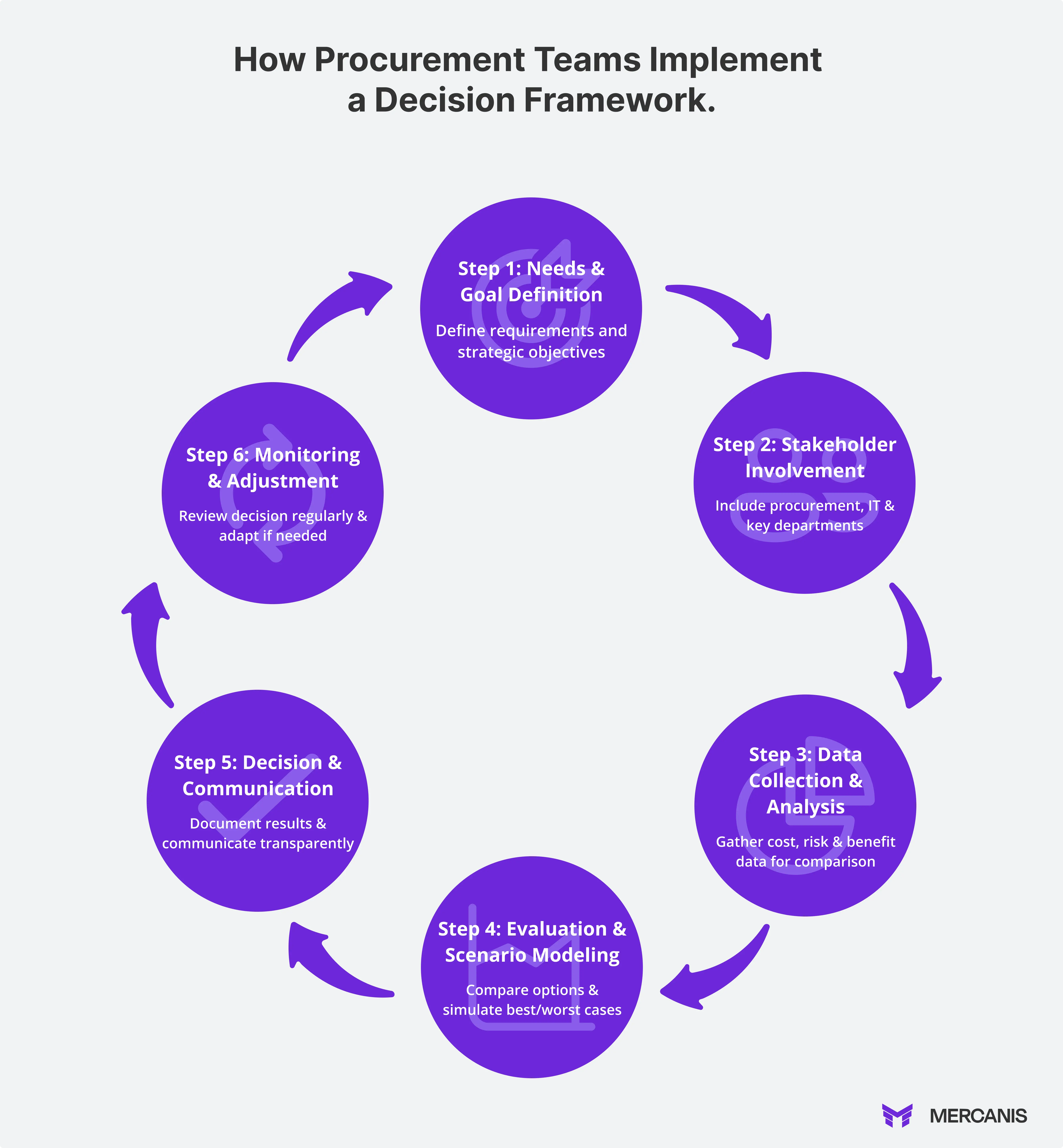
A global automotive supplier is faced with a crucial question:
Should the new AI-supported procurement tool be developed internally or purchased externally?
The internal team knows the processes in detail, but the market solutions promise shorter implementation times and lower risks.
This is exactly where decision frameworks come into play. They help purchasing teams make complex make-or-buy decisions in a structured, transparent, and data-driven manner, while maximizing return on investment (ROI).
A decision framework is a structured evaluation approach that helps companies systematically weigh the pros and cons of in-house development (make) and external procurement (buy).
It breaks down the decision-making process into clear phases, from defining objectives to the final decision, and takes into account factors such as costs, risks, resources, and strategic fit.
Practical example:
By using a structured framework, comparable projects were able to reduce development time by 20% to 40%.Vorteile strukturierter Make-or-Buy-Entscheidungen im Einkauf

In-house development (build) of an AI-supported procurement tool offers numerous advantages, but also some challenges. The strengths include complete control over the software, tailor-made adaptations to specific business processes, and the protection of sensitive data without external access. In addition, manufacturers can increase their competitiveness through individual innovations by developing their own software.
On the other hand, the build approach requires considerable investment in personnel, infrastructure, and time. Development costs are often high, and there is a risk of delays or technical problems. In addition, companies must ensure that they have the necessary expertise for maintenance, further development, and security in order to secure long-term added value.
Overall, the build approach makes particular sense if the company has specialized resources and the software plays a strategically critical role in the procurement process.
Buying an AI-supported procurement tool offers the advantage of rapid implementation and lower initial investment. External solutions are often tried and tested, receive regular updates, and guarantee high availability and security thanks to professional providers. Companies also benefit from support services and the opportunity to draw on proven best practices and innovations in the market.
However, the buy approach also has its limitations: the options for adapting to specific business processes are limited, and there is a certain risk regarding data protection and control over sensitive data, as this is often stored in the cloud or with third-party providers. In addition, license costs and dependencies on external providers can lead to higher overall costs in the long term.
Overall, purchasing is particularly suitable for companies that need a reliable solution quickly, have limited internal resources, or want to benefit from the advantages of standardized products and services.

Cost-benefit analysis forms the foundation of any economic evaluation. It compares all expenses—from development and licensing to maintenance and training—with the expected benefits, such as efficiency gains or quality improvements.
Typical key figures are payback period, net present value (NPV), and return on investment (ROI).
Practical example:
A manufacturing company analyzed the introduction of an automated ordering platform. The calculation showed that despite high initial investments, the system paid for itself after 18 months thanks to 25% faster ordering processes and significantly reduced error rates.
The Business Case Method (BCM) extends classic calculations to include qualitative factors such as project risks, integration costs, and dependencies on third-party providers. This allows best- and worst-case scenarios to be simulated and decisions to be made more realistically.
Practical example:
A chemical company examined the in-house development of a supplier portal. The BCM analysis showed that time overruns and interface problems could cause high additional costs. The risk simulation showed that an external solution with the same range of functions was more reliable in terms of planning and more cost-efficient.
The SWOT analysis (strengths, weaknesses, opportunities, threats) is a popular model for make-or-buy decision-making from a strategic perspective. It highlights internal strengths and weaknesses as well as external opportunities and threats in order to incorporate long-term goals such as innovation capability, flexibility, and market position.
Practical example:
An automotive supplier was faced with the decision of whether to develop its own e-procurement system or license a cloud solution. The SWOT analysis revealed that while in-house development offered more control over data, the cloud option was more appealing due to its scalability and lower maintenance costs. Strategically, the choice fell on the SaaS solution – in line with the company's vision of an agile, digitally networked supply chain.
A structured decision framework helps purchasing teams make complex make-or-buy decisions in a transparent, data-driven, and strategically sound manner. The following steps show how the process works in practice:

The first step is to define the specific requirements for the planned AI tool and the overarching corporate goals. Is the primary focus on cost efficiency, technological independence, or speed of innovation? Clear objectives create the basis for clearly prioritizing decision criteria such as budget, scope of functions, or integration capability.
An effective framework thrives on interdisciplinary collaboration. Purchasing, IT, specialist departments, and, if necessary, external consultants should be involved at an early stage. This allows different perspectives and requirements to be taken into account – for example, technical feasibility, data architecture, or compliance requirements. Early coordination prevents conflicts of interest and increases acceptance of the final decision.
The next step is to collect all relevant data on costs, benefits, and risks. This includes licensing and development costs as well as potential productivity gains or security risks. Structured data collection forms the backbone of any objective decision and enables reliable comparisons between internal development and external procurement.
The next step is to apply the selected framework—such as cost-benefit, BCM, or SWOT analysis. This involves combining quantitative metrics (e.g., ROI, NPV) with qualitative factors (e.g., strategic fit, innovation potential). Scenario modeling allows different future situations to be simulated – from optimistic to pessimistic scenarios – enabling more informed decisions to be made.
The final decision should be transparently documented and justified. A clear decision report shows which alternatives were considered and which criteria were decisive. Equally important is internal communication. If all stakeholders can understand the decision, acceptance increases and with it the likelihood of successful implementation.
A decision framework is not a one-time tool, but a dynamic process. Market conditions, technologies, and corporate strategies change – and with them, the basis for decision-making. Regular reviews help to validate the original decision and adjust it if necessary, for example when new suppliers, cost advantages, or risks arise.
Artificial intelligence is fundamentally changing decision-making in purchasing. Whereas decisions used to be based heavily on experience, gut feeling, and manual data analysis, AI-supported systems now enable objective, data-driven, and reproducible evaluations. Gartner predicts that AI agents will support around 50% of business decisions in the coming years.
AI tools process large amounts of data in real time, recognize patterns and correlations that often remain hidden to human analysts, and simulate different scenarios – such as price developments, supplier risks, or changes in demand. This allows opportunities and risks to be assessed not only faster, but also more accurately.
In modern decision frameworks, AI solutions therefore take on the role of an intelligent analysis and forecasting partner. They provide the basis for fact-based decisions by linking historical data with external factors such as market trends, geopolitical risks, or ESG criteria. This is particularly valuable in dynamic procurement markets, where small changes can have a major impact on costs and delivery capabilities.
At the same time, human expertise remains indispensable. AI provides data and recommendations for action, but the final decision requires strategic thinking, contextual understanding, and ethical considerations. The goal is therefore not to automate the decision itself, but to improve its quality: bias is reduced, transparency is increased, and the risk of wrong decisions is significantly lowered.
Practical example:
A global industrial company integrates AI-based risk analyses into its make-or-buy framework. The system automatically evaluates supplier stability, currency fluctuations, and raw material prices. Based on these analyses, management receives several action scenarios – from short-term savings potential to long-term resilience strategies. The final decision is made by the purchasing team, supported by the AI insights.
Structured decision frameworks are indispensable today for making informed purchasing decisions using AI tools.
They create transparency, promote cross-functional collaboration, and ensure long-term strategic value and ROI.
Tip: If you want to make strategic make-or-buy decisions in purchasing, you should start small – with a pilot project, clear KPIs, and data-based analysis.

Between 4 and 8 weeks, depending on the complexity.

Costs, benefits, risks, strategic fit, technical feasibility, and resource availability.

No – it supports but does not replace human evaluation.

Through KPIs such as ROI, process time, implementation quality, and user satisfaction in purchasing.





